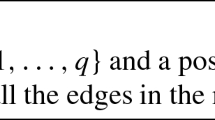Abstract
In the exact matching problem we are given a graph G, some of whose edges are colored red, and a positive integer k. The goal is to determine if G has a perfect matching, exactly k edges of which are red. More generally if the matching number of G is m=m(G), the goal is to find a matching with m edges, exactly k edges of which are red, or determine that no such matching exists. This problem is one of the few remaining problems that have efficient randomized algorithms (in fact, this problem is in RNC), but for which no polynomial time deterministic algorithm is known.
Our first result shows that, in a sense, this problem is as close to being in P as one can get. We give a polynomial time deterministic algorithm that either correctly decides that no maximum matching has exactly k red edges, or exhibits a matching with m(G)−1 edges having exactly k red edges. Hence, the additive error is one.
We also present an efficient algorithm for the exact matching problem in families of graphs for which this problem is known to be tractable. We show how to count the number of exact perfect matchings in K 3,3-minor free graphs (these include all planar graphs as well as many others) in O(n 3.19) worst case time. Our algorithm can also count the number of perfect matchings in K 3,3-minor free graphs in O(n 2.19) time.
Similar content being viewed by others
References
Alon, N., Seymour, P.D., Thomas, R.: A separator theorem for nonplanar graphs. J. Am. Math. Soc. 3(4), 801–808 (1990)
Asano, T.: An approach to the subgraph homeomorphism problem. Theor. Comput. Sci. 38, 249–267 (1985)
Berger, A., Bonifaci, V., Grandoni, F., Schäfer, G.: Budgeted matching and budgeted matroid intersection via the gasoline puzzle. In: Proc. of 13th IPCO, pp. 273–287 (2008)
Coppersmith, D., Winograd, S.: Matrix multiplication via arithmetic progressions. J. Symb. Comput. 9, 251–280 (1990)
Gabow, H.N., Tarjan, R.E.: Faster scaling algorithms for general graph matching problems. J. ACM 38(4), 815–853 (1991)
Galluccio, A., Loebl, M.: On the theory of Pfaffian orientations. I. Perfect matchings and permanents. Electron. J. Comb. 6, #R6 (1999)
George, A.: Nested dissection of a regular finite element mesh. SIAM J. Numer. Anal. 10, 345–363 (1973)
Gilbert, J.R., Tarjan, R.E.: The analysis of a nested dissection algorithm. Numer. Math. 50(4), 377–404 (1987)
Hopcroft, J.E., Tarjan, R.E.: Dividing a graph into triconnected components. SIAM J. Comput. 2(3), 135–158 (1973)
Karp, R., Upfal, E., Wigderson, A.: Constructing a perfect matching is in random NC. Combinatorica 6, 35–48 (1986)
Kasteleyn, P.W.: Graph theory and crystal physics. In: Graph Theory and Theoretical Physics, pp. 43–110. Academic Press, London (1967)
Lipton, R.J., Rose, D.J., Tarjan, R.E.: Generalized nested dissection. SIAM J. Numer. Anal. 16(2), 346–358 (1979)
Lipton, R.J., Tarjan, R.E.: A separator theorem for planar graphs. SIAM J. Appl. Math. 36(2), 177–189 (1979)
Little, C.H.C.: An extension of Kasteleyn’s method of enumerating the 1-factors of planar graphs. In: Holton, D. (ed.) Combinatorial Mathematics, Proc. 2nd Australian Conference. Lecture Notes in Mathematics, vol. 403, pp. 63–72 (1974)
Mucha, M., Sankowski, P.: Maximum matchings in planar graphs via Gaussian elimination. Algorithmica 45, 3–20 (2006)
Mulmuley, K., Vazirani, U.V., Vazirani, V.V.: Matching is as easy as matrix inversion. Combinatorica 7(1), 105–113 (1987)
Papadimitriou, C.H., Yannakakis, M.: The complexity of restricted spanning tree problems. J. ACM 29(2), 285–309 (1982)
Tutte, W.T.: The factorization of linear graphs. J. Lond. Math. Soc. 22, 107–111 (1947)
Vazirani, V.V.: NC algorithms for computing the number of perfect matchings in K 3,3-free graphs and related problems. Inf. Comput. 80(2), 152–164 (1989)
Yuster, R., Zwick, U.: Maximum matching in graphs with an excluded minor. In: Proc. of 18th SODA, pp. 108–117 (2007)
Author information
Authors and Affiliations
Corresponding author
Additional information
A preliminary version of this paper appeared in Proceedings of the 10th International Workshop, APPROX 2007 and 11th International Workshop, RANDOM 2007, Princeton, NJ, USA, August 2007.
Rights and permissions
About this article
Cite this article
Yuster, R. Almost Exact Matchings. Algorithmica 63, 39–50 (2012). https://doi.org/10.1007/s00453-011-9519-0
Received:
Accepted:
Published:
Issue Date:
DOI: https://doi.org/10.1007/s00453-011-9519-0




